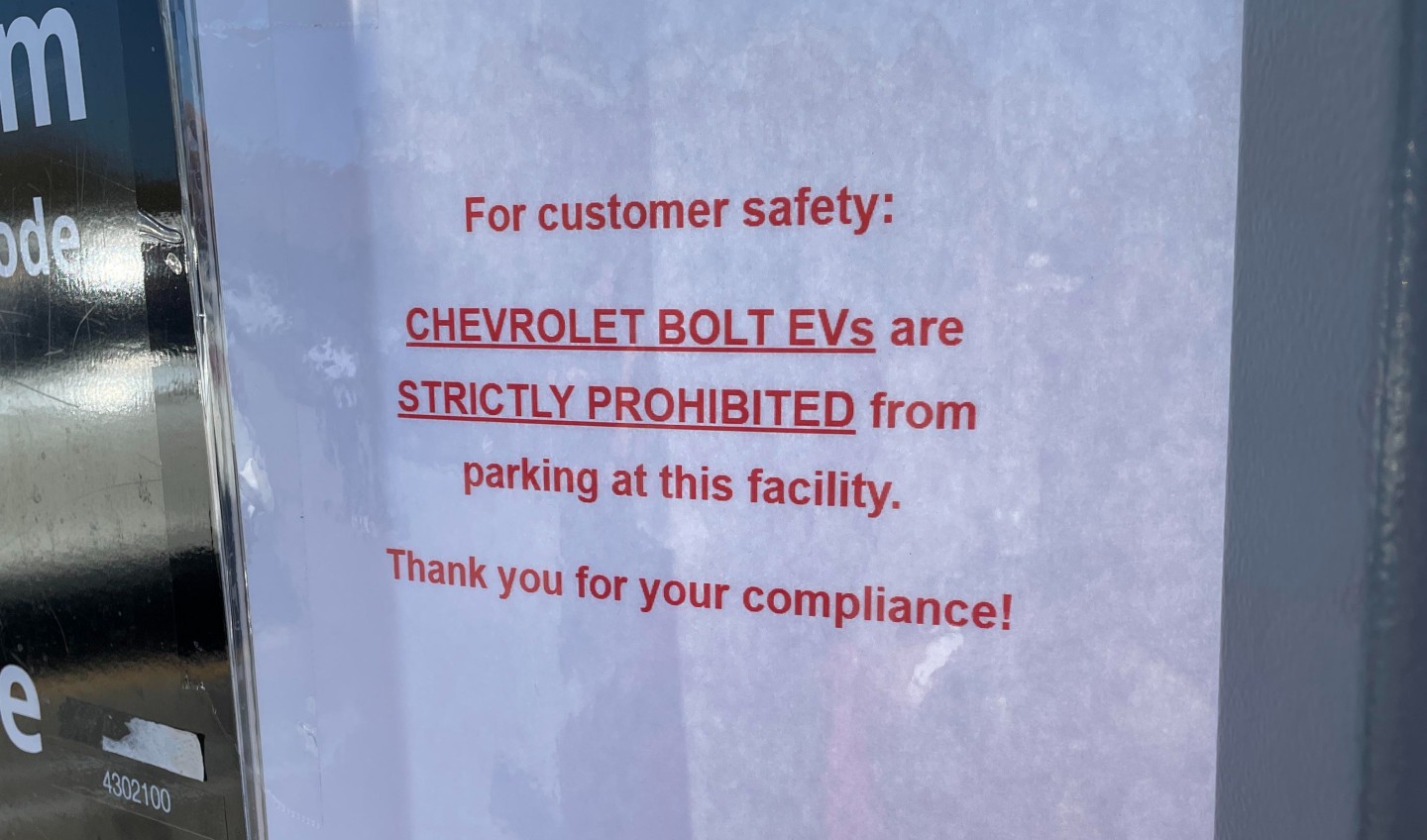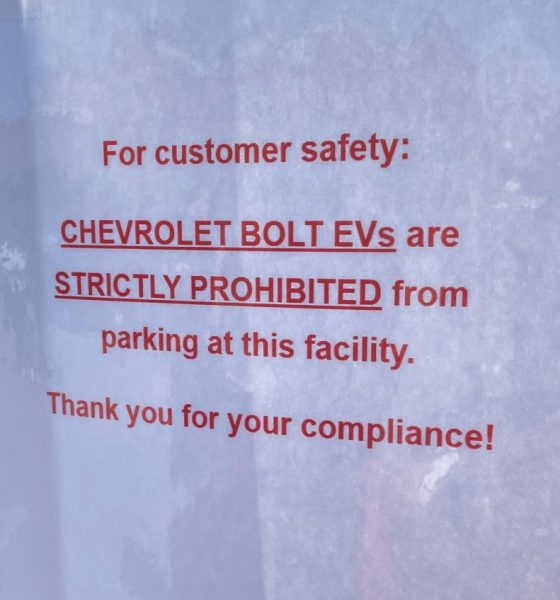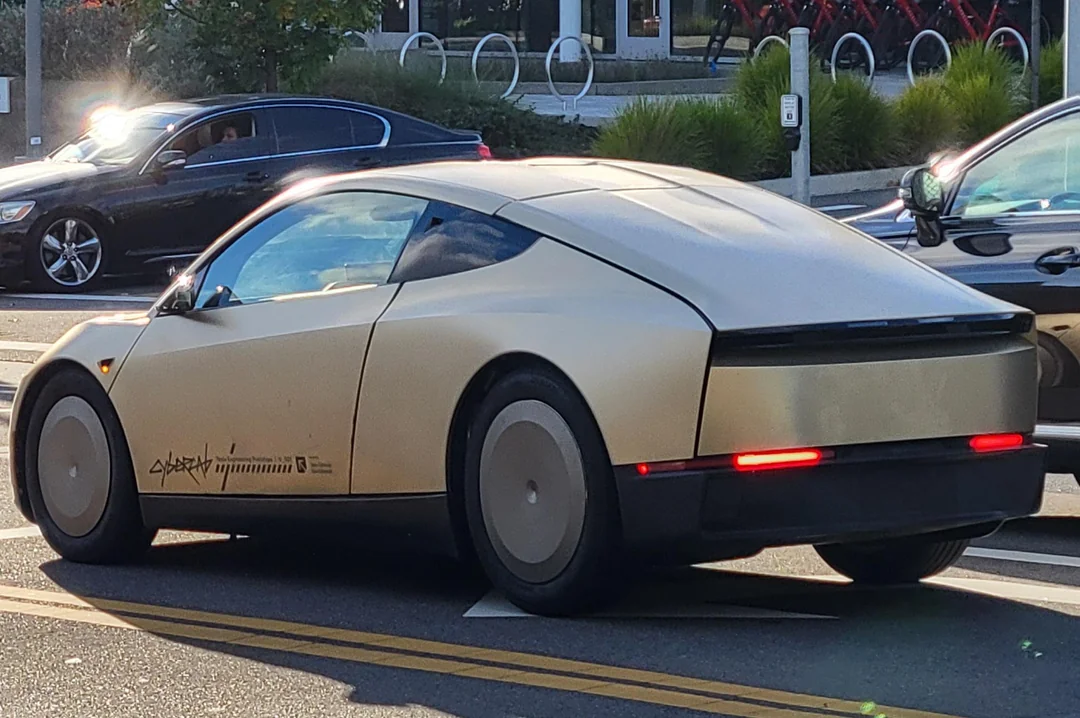

News
Chevrolet Bolt EV owners may have trouble with parking after battery recalls
Chevrolet Bolt EVs have been in the news quite frequently as of late due to their extensive recall from General Motors due to battery cell malfunctions that could cause fires. However, a parking lot is taking precautions to an extreme measure by banning Bolt EVs from their facility due to the recalls, which have been heavily covered in the past few weeks.
The Bolt EV has had recalls three times over the past year due to battery issues. The first was in November 2020, with the second and third coming within the last several months after battery malfunctions in cells provided by LG Energy Solutions could have “the simultaneous presence of two rare manufacturing defects in the same battery cell.” GM’s second recall covered 69,000 vehicles total. Still, the company then decided to extend the recall by spending an additional billion dollars on other vehicles that were not listed in the initial recalls “out of an abundance of caution.” So far, GM has spent $1.8 billion on the recall since Q2.
How the Chevy Bolt EV became GM’s 1.8 billion dollar problem
GM encouraged owners to limit their state of charge to 90% and avoid depleting their battery below 70 miles of remaining range when possible. Additionally, owners were encouraged to park their vehicles outside after charging and not charge their cars overnight as a precaution.
Because of the mass amount of media attention the Bolt EV recall has received, some entities are now banning the vehicle’s presence on its premises. A parking lot in San Francisco is one example.
A sign was seen at the lot by Reddit user u/scarls13, who took a picture of the warning that read:
“For customer safety:
CHEVROLET BOLT EVs are STRICTLY PROHIBITED from parking at this facility.
Thank you for your compliance!”
The owner of the lot likely was taking a necessary and understandable precaution, but this sort of message could be detrimental to the development of electric vehicles. Just as media coverage fixates on instances of Tesla Autopilot irresponsibilities, EV fires, and commonly spread misinformation regarding EVs in general, the Bolt EV story has become a mainstay of fear for those who are still skeptical of the EV movement. It is important to remember that GM, Chevrolet, and LG Energy Solutions have taken drastic steps to fix the issue, even recalling non-effected vehicles to have battery packs replaced to prevent further events of combustion.
Statistically, EV fires are not a common occurrence. FEMA stated that 171,500 vehicle fires occurred annually on average between 2014 and 2016. Only 10 of these fires were Bolts, and ICE vehicles made up a vast majority of the vehicles that caught fire. The 269 million vehicles on the road in the U.S. in 2016 and one in 1,569 fossil fuel-powered vehicles caught fire during that time. Furthermore, there were 1.2 million EVs in China in 2018, but one in 30,000 vehicles caught fire. This effectively means that an ICE vehicle was twenty-times more likely to catch fire than an EV, according to Forbes.
Of course, it is understandable to be preventative and safe, but the Bolt EV fires are still a statistically rare occurrence. GM admitting its wrongs and pushing toward full replacements of battery cells to prevent future instances of fires should begin to take control of signs like the ones above, but lot owners are within their rights to refuse service to anyone for any reason.
Don’t hesitate to contact us with tips! Email us at tips@teslarati.com, or you can email me directly at joey@teslarati.com.

News
Tesla Model 3 named New Zealand’s best passenger car of 2025
Tesla flipped the switch on Full Self-Driving (Supervised) in September, turning every Model 3 and Model Y into New Zealand’s most advanced production car overnight.

The refreshed Tesla Model 3 has won the DRIVEN Car Guide AA Insurance NZ Car of the Year 2025 award in the Passenger Car category, beating all traditional and electric rivals.
Judges praised the all-electric sedan’s driving dynamics, value-packed EV tech, and the game-changing addition of Full Self-Driving (Supervised) that went live in New Zealand this September.
Why the Model 3 clinched the crown
DRIVEN admitted they were late to the “Highland” party because the updated sedan arrived in New Zealand as a 2024 model, just before the new Model Y stole the headlines. Yet two things forced a re-evaluation this year.
First, experiencing the new Model Y reminded testers how many big upgrades originated in the Model 3, such as the smoother ride, quieter cabin, ventilated seats, rear touchscreen, and stalk-less minimalist interior. Second, and far more importantly, Tesla flipped the switch on Full Self-Driving (Supervised) in September, turning every Model 3 and Model Y into New Zealand’s most advanced production car overnight.
FSD changes everything for Kiwi buyers
The publication called the entry-level rear-wheel-drive version “good to drive and represents a lot of EV technology for the money,” but highlighted that FSD elevates it into another league. “Make no mistake, despite the ‘Supervised’ bit in the name that requires you to remain ready to take control, it’s autonomous and very capable in some surprisingly tricky scenarios,” the review stated.
At NZ$11,400, FSD is far from cheap, but Tesla also offers FSD (Supervised) on a $159 monthly subscription, making the tech accessible without the full upfront investment. That’s a game-changer, as it allows users to access the company’s most advanced system without forking over a huge amount of money.
News
Tesla starts rolling out FSD V14.2.1 to AI4 vehicles including Cybertruck
FSD V14.2.1 was released just about a week after the initial FSD V14.2 update was rolled out.

It appears that the Tesla AI team burned the midnight oil, allowing them to release FSD V14.2.1 on Thanksgiving. The update has been reported by Tesla owners with AI4 vehicles, as well as Cybertruck owners.
For the Tesla AI team, at least, it appears that work really does not stop.
FSD V14.2.1
Initial posts about FSD V14.2.1 were shared by Tesla owners on social media platform X. As per the Tesla owners, V14.2.1 appears to be a point update that’s designed to polish the features and capacities that have been available in FSD V14. A look at the release notes for FSD V14.2.1, however, shows that an extra line has been added.
“Camera visibility can lead to increased attention monitoring sensitivity.”
Whether this could lead to more drivers being alerted to pay attention to the roads more remains to be seen. This would likely become evident as soon as the first batch of videos from Tesla owners who received V14.21 start sharing their first drive impressions of the update. Despite the update being released on Thanksgiving, it would not be surprising if first impressions videos of FSD V14.2.1 are shared today, just the same.
Rapid FSD releases
What is rather interesting and impressive is the fact that FSD V14.2.1 was released just about a week after the initial FSD V14.2 update was rolled out. This bodes well for Tesla’s FSD users, especially since CEO Elon Musk has stated in the past that the V14.2 series will be for “widespread use.”
FSD V14 has so far received numerous positive reviews from Tesla owners, with numerous drivers noting that the system now drives better than most human drivers because it is cautious, confident, and considerate at the same time. The only question now, really, is if the V14.2 series does make it to the company’s wide FSD fleet, which is still populated by numerous HW3 vehicles.
News
Waymo rider data hints that Tesla’s Cybercab strategy might be the smartest, after all
These observations all but validate Tesla’s controversial two-seat Cybercab strategy, which has caught a lot of criticism since it was unveiled last year.

Toyota Connected Europe designer Karim Dia Toubajie has highlighted a particular trend that became evident in Waymo’s Q3 2025 occupancy stats. As it turned out, 90% of the trips taken by the driverless taxis carried two or fewer passengers.
These observations all but validate Tesla’s controversial two-seat Cybercab strategy, which has caught a lot of criticism since it was unveiled last year.
Toyota designer observes a trend
Karim Dia Toubajie, Lead Product Designer (Sustainable Mobility) at Toyota Connected Europe, analyzed Waymo’s latest California Public Utilities Commission filings and posted the results on LinkedIn this week.
“90% of robotaxi trips have 2 or less passengers, so why are we using 5-seater vehicles?” Toubajie asked. He continued: “90% of trips have 2 or less people, 75% of trips have 1 or less people.” He accompanied his comments with a graphic showing Waymo’s occupancy rates, which showed 71% of trips having one passenger, 15% of trips having two passengers, 6% of trips having three passengers, 5% of trips having zero passengers, and only 3% of trips having four passengers.
The data excludes operational trips like depot runs or charging, though Toubajie pointed out that most of the time, Waymo’s massive self-driving taxis are really just transporting 1 or 2 people, at times even no passengers at all. “This means that most of the time, the vehicle being used significantly outweighs the needs of the trip,” the Toyota designer wrote in his post.
Cybercab suddenly looks perfectly sized
Toubajie gave a nod to Tesla’s approach. “The Tesla Cybercab announced in 2024, is a 2-seater robotaxi with a 50kWh battery but I still believe this is on the larger side of what’s required for most trips,” he wrote.
With Waymo’s own numbers now proving 90% of demand fits two seats or fewer, the wheel-less, lidar-free Cybercab now looks like the smartest play in the room. The Cybercab is designed to be easy to produce, with CEO Elon Musk commenting that its product line would resemble a consumer electronics factory more than an automotive plant. This means that the Cybercab could saturate the roads quickly once it is deployed.
While the Cybercab will likely take the lion’s share of Tesla’s ride-hailing passengers, the Model 3 sedan and Model Y crossover would be perfect for the remaining 9% of riders who require larger vehicles. This should be easy to implement for Tesla, as the Model Y and Model 3 are both mass-market vehicles.









